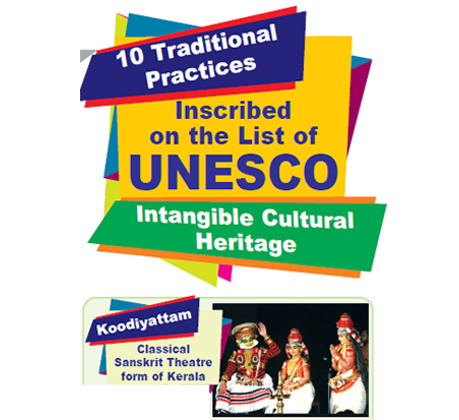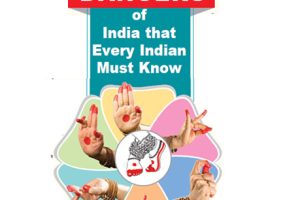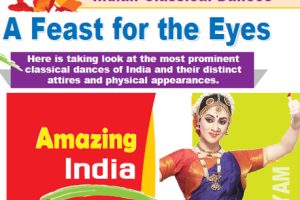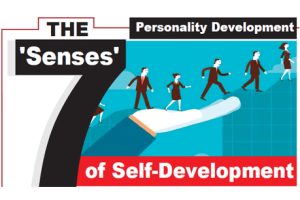India is a land of diverse cultures. Despite the differences, a unique harmony co-exists with its cultural diversity, which has attracted and mesmerized millions of people from all parts of the world. Conservation of the rich heritage and
culture in India is not limited to the monuments, buildings, forts, handicrafts, and objects, which are tangible in nature, but also include preserving the traditions, rituals, social practices, performing arts and festive events, which are
intangible in nature.
This intangible cultural heritage inherited from our ancestors and transmitted to our descendants is an important factor in maintaining unity in the cultural diversity of the nation. Since 2008, UNESCO has been creating a list of intangible
cultural practices from all over the world with the aim of providing better protection to them and creating global awareness of their significance in the communities. We are presenting a brief description of the 10 traditional practices of
India inscribed on the list of UNESCO intangible cultural heritage.
10 Traditional Practices
Inscribed on the List of UNESCO
Intangible Cultural Heritage
Koodiyattam
Classical Sanskrit Theatre form of Kerala
Koodiyattam: Classical Sanskrit Theatre form of Kerala
Originated about 2000 years ago, Koodiyattam is the oldest surviving classical form of Sanskrit theatre in India. It represents that part of the culture in India, which is sacred in nature and is usually performed in Koothambalams or temple
theatres located in the Hindu temples of Kerala. The word ‘Koodiyattam’ literally means ‘performing together’. It is performed by the male artist Chakyar, a temple caste of Kerala, and the female artist Nangiar, the woman of Nambiar caste.
A special percussion instrument called Mizhavu is played in the background by a member of Nambiar caste. Make-up and costume, verbal acting, facial expressions, hand gesture, and body movements have great significance in Koodiyattam. With a
performance of about five hours a day, it takes 20 days to 40 days to enact a complete performance of Koodiyattam.
Vedic Chanting
Perfect Oral Tradition to Preserve Ancient Vedic Culture in India
Vedic chanting Vedas, the infinite library of knowledge, was revealed to the ancient sages of India when they were in a deep state of meditation. Vedas comprise a vast ocean of information on every conceivable subject including philosophy,
science, arts, myths, and rituals. Rig Veda, Yajur Veda, Sama Veda, and Atharva Veda are the four Vedas, which are undoubtedly the most authentic source of Indian wisdom. The Sanskrit verses of these “books of knowledge” were chanted during
sacred rituals and recited daily by the Brahmin community. Vedic chanting refers to the traditional way of reciting the Vedas with complex recitation techniques taught and practiced from childhood, which helps in preserving this sacred
foundation of Hinduism over thousands of years. The recitation which is a part of the culture in India, giving importance to tonal accents and precise speech combinations, ensures that the sound of each word remains unaltered.
Kalbelia
Folk Songs and Dances of Snake Charmers of Rajasthan
Kalbelia is an enchanting dance form performed by the Kalbelia tribe, a nomadic community of professional snake charmers, in the state of Rajasthan. Women dancers wearing flowing skirts of black and red hues resemble the movement of
serpents while the male performers accompany them with music on percussion instruments and a woodwind instrument called Poongi, which was traditionally played to enchant snakes. The colorful costumes of the dancers have traditional designs
adorned with small mirrors and silver thread. The dance and song form part of an oral tradition and culture in India with no written texts and the singers often compose songs spontaneously. As the dance progresses the rhythm becomes faster
and faster, giving an amazing visual treat to the spectators.
Mudiyettu
Mythological Ritual Dance Drama of Kerala
Mudiyettu is a traditional ritual dance-drama performed in the Goddess temples of Kerala based on the legendary tale of a fight between goddess Kali and demon Darika. Several characters appear in this drama in different scenes and it is
concluded by the slaying of the demon by the goddess. The entire village participates in this community ritual which forms a part of the culture in India, which is celebrated after the summer harvest season. The performers observe several
days of penance by fasting and prayer. They draw a huge image of the goddess Kali, known as kalam, on the temple floor with colored powders to invoke the spirit of the goddess and the drama begins with the accompaniment of the music of
drums and cymbals. Colorful costumes, heavy make-up, and huge headgears are the highlights of the show.
Ramlila
Traditional Theatre Art form of Ramayana
Ramlila, literally meaning “Rama’s Play”, is a theatre art form based on the famous Indian epic Ramayana, traditionally performed in Northern India during Dusserah celebrations. Ramlilas at Ramnagar, Ayodhya, Benares, Vrindavan, Satna,
Almora and Madhubani are the most illustrative ones. It usually lasts for 10 days, but in certain places like Ramnagar, it lasts a whole month. It is a colorful performance with a series of episodes including songs, narrations, recitals and
actions and concludes by the victory of Lord Rama over the demon king Ravana. This unique culture of India reflects the festival spirit of Dusserah and brings the whole people and communities together beyond any distinction of caste,
religion or age.
Ramman
Religious Cultural Event of Uttarakhand
Ramman is a multiform cultural event celebrated in the Saloor- Dungra villages in Chamoli district in the state of Uttarakhand. It is a combination of theatre, music and historical presentation of Indian art and culture with oral and
written tales and highly complex rituals comprising masked dances, songs, and recitation from Ramayana and other legends. This 10-day festival, celebrated in honor of the deity Bhumiyal Devta, begins on the day of Baisakhi. Ramman is
organized by the whole villagers with the specific role assigned to each caste and group of people. Brahmins do the rituals and prayers; talented youth and elders perform the songs and dances; drummers of the Das community play drums and
Bhandari’s representing the Kshatriya caste perform the mask dance of Narasimha.
Chhau Dance
Tribal Battle Dance from Eastern India
Chhau dance, also known as Paika Nrutya, literally meaning ‘Battle Dance’, is a tribal dance performed in the states of West Bengal, Odisha, and Jharkhand. It is connected to regional festivals, especially the spring festival Chaitra Parva.
This tribal culture in India is classified into three different styles belonging to the regions of Purulia, Seraikella, and Mayurbhanj. The first two styles use masks and the Mayurbhanj style uses none. Chhau dance is performed at night in
open space and involves the collective participation of people from different communities irrespective of their social status, beliefs, and professions. The themes of the dance include stories from Ramayana, Mahabharata, and local legends.
The dance is performed by men and the movement includes combat techniques, movements of birds and animals, etc., in the background of echoing drumbeats and music of shehnai.
Buddhist Chanting
Spiritual Practice of Ladakh Region
In the Ladakh region of Jammu & Kashmir, Buddhist Lamas wearing special ritual clothing and using unique hand gestures chant sacred texts representing the philosophy and teachings of Buddha. This sacred culture in India is an artistic
expression performed for the spiritual well-being of the people, their peace of mind and for evoking the blessings of Lord Buddha.
There are two forms of Buddhism and four major sects in Ladakh, each sect practicing several forms of chanting on important days.
The chanting is usually performed in a group by sitting indoors or accompanied by dances in the courtyards of the monastery. Instruments like drums, bells, cymbals, and trumpets add music and rhythm to the sacred
chanting. The chanting is practiced every day by the practitioners under the strict supervision of senior monks.
Brass and Copper Utensil Making
A Traditional Craft of Punjab
A group of craftspeople called Thathera of the Jandiala community in Punjab manufactures brass and copper utensils using a traditional craft transmitted orally from father to son. The metals used are copper, brass, and certain alloys of
copper, Tin, and Zinc. Cooled metal sheets are flattened into thin plates and hammered into specific curved shapes to create utensils of different sizes starting from small bowls to huge cooking vessels. Heating of the vessels while
hammering is done by using small wood-fired stoves buried in the ground and controlled by hand-held bellows.
Polishing is done using materials like sand and tamarind juice and designs are engraved by carefully hammering a number of tiny dents on the heated surface.
The utensils are beneficial for health but the maintenance is time-consuming.
Sankirtana
A Vibrant Ritual Art form of Manipur
Sankirtana, an art form which involves ritual singing, drumming, and dancing, is performed by the Vaishnava community of Manipur during religious occasions. Two drummers and about ten singer-cum-dancers perform the show by narrating stories
of Krishna through song and dance. The artistic excellence and spiritual energy of Sankirtana are incomparable, capturing the hearts of the devotees seated around. It is a vibrant spiritual practice and a dignified culture in India that
unites the people within the Vaishnava community together on religious occasions throughout the year.
The distinctive feature of Sankirtana is that the singing uses 100 types of taals or rhythmic variations. Apart from the above UNESCO
recognized list, there are hundreds of cultural practices in our country which have been passed down from one generation to another and contributed as powerful forces of social cohesion. These living expressions exemplify the rich heritage
and culture of India, unite all individuals together, motivate them with a sense of responsibility, and help them feel part of one community; the community of humanity.

















Add Comment